LEAVES FROM OUR TREE:
Rev. Timothy Carrington's
Ministry

The following narrative of Rev. Timothy's career
as a Baptist minister was researched and contributed
by one of his 4th great granddaughters (through son,
Osborne), Diane Carrington Bradford.
In addition to farming his land, Timothy Carrington
became a Baptist minister after settling in Georgia.
Nothing was ever found to indicate he was a minister
or even a church member while living in Virginia or
North Carolina. Georgia Baptist Association records
in the Baptist Archives housed at Mercer University,
Macon, Georgia, indicated that Rev. Timothy served several
churches over a 31-year span:
Carrington, Timothy: Clarks Station 1788 Millstone
1790 Georgia
Assoc. 1788-- Ord. by 1790 Clouds Creek 1792
Asplund 1790 Ord. Millstone, Wilkes Co. [later Oglethorpe
Co.]
Sarepta Assoc. had written circular letter
in 1803 Skull Shoals in Elbert Co. 1804 Sarepta
Assoc. 1804 Asked to write letter to Bethel Assoc.
S.C. 1804 Messenger to Georgia Assoc.
[verbatim excerpt from the "List
of Baptist Ministers and the Churches They Served,"
a reference list compiled for use of the librarians
in the Special Collections Room at the Tarver Library,
Mercer University, Macon, Georgia.]
In the minutes of the various association meetings
of 1788, 1790, 1792 and 1793, the names of the ordained
ministers always were printed in CAPITALS, the unordained
preachers were in italics. and delegates to the
meeting were in plain type. In 1788 Rev. Timothy's name
was in plain type indicating he was simply a lay delegate
to the Georgia Association meeting at Clark's Station.
In 1790 his name was in all caps indicating he was the
ordained minister representing his pastorate at Millstone
Baptist, and in 1792 and 1793, his pastorate at Cloud's
Creek.
Timothy worked as an an unordained licentiate preacher
at Clark's Station Baptist Church in 1788 in Wilkes
County, Georgia. According to the meeting minutes the
church had 37 members. He was also a lay delegate to
the Georgia Association Meeting that year along with
Rev. Matthew Talbot, pastor of Clarks Station Baptist,
Stephen Johnson, Thomas Gilbert and Godfrey Hartsfield.
Timothy was ordained a minister of the gospel at
Millstone Baptist Church by 1790 in Wilkes County, Georgia.
That part of Wilkes County became Oglethorpe County
on December 19, 1793.
A History of the Georgia Baptist Association,
by Jesse Mercer [Washington, GA, 1838, reprinted by
the Georgia Baptist Association, Washington, GA, in
1980, p 21] stated that the minutes of the association
meeting held in October 1788 at Clark's Station Baptist
Church showed that 31 churches were represented and
there were 20 ministers and 12 licentiates in attendance.
The minutes of the association meeting held in October
1792 at Fishing Creek Baptist Church in Wilkes, County,
GA, indicated that the number of associate churches
had increased to 56 and the number of ordained ministers
increased by 17, including Rev. Timothy Carrington [p
28].
In 1790 the State of Georgia had nine (9) counties
and there were 35 Baptist churches serving 2,406 members.
One of those churches was Millstone Creek (organized
in 1786 in Wilkes County) with Pastor Timothy Carrington.
According to the Minutes of the Georgia Association
Meeting held at Reed's Creek on Oct 16, 1790, Millstone
Baptist Church had 51 members that year, one member
was baptized and 2 were "received by letter"
[when they joined the church]. Delegates to the Association
meeting were Rev. Timothy Carrington, pastor, James
Dye and Jesse Willingham. [The Annual Register of
the Baptist Denomination in North America by John
Asplund. (Baptist Historical Society Library, Mercer
University, Macon, Georgia)].
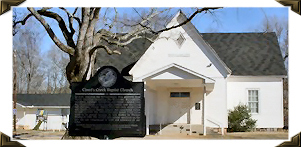 Timothy
served as pastor Of Cloud's Creek Baptist Church in
1792 and 1793 in Wilkes County, Georgia. In 1792 Rev.
Timothy Carrington was the only delegate from Cloud's
Creek to the Georgia Association Meeting. That year
he reported that the church had 57 members, two of which
were received by baptism and six were received by letter.
In 1793 Rev. Timothy Carrington, pastor, and Isaiah
Hales, a licensed preacher, were the Cloud's Creek delegates
to the Georgia Association meeting. He reported a membership
of 53, of which 3 were baptized, 7 were received by
letter, and 3 were excommunicated. Timothy
served as pastor Of Cloud's Creek Baptist Church in
1792 and 1793 in Wilkes County, Georgia. In 1792 Rev.
Timothy Carrington was the only delegate from Cloud's
Creek to the Georgia Association Meeting. That year
he reported that the church had 57 members, two of which
were received by baptism and six were received by letter.
In 1793 Rev. Timothy Carrington, pastor, and Isaiah
Hales, a licensed preacher, were the Cloud's Creek delegates
to the Georgia Association meeting. He reported a membership
of 53, of which 3 were baptized, 7 were received by
letter, and 3 were excommunicated.
In 1794 Timothy Carrington was listed as pastor
of Cloud's Creek Baptist Church. Membership figures
reported were 1790-35, 1791-43, 1792-51. [Ibid.]
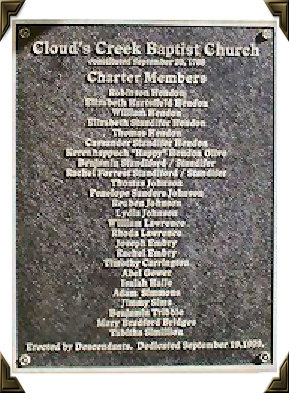 Cloud's
Creek Baptist Church was organized Sep 20, 1788 with
charter members: Jos. Embrey, Robertson Hendon, Thos.
Hendon, Jimmy Smith, William Hendon, Benjamin Staniford,
William Lawrence, Ruben Johnson, Thos. Johnson, Abel
Gower, Benjamin Tribble, Adam Simmons, Timothy Carrington,
Isaiah Hales, Rachel Embry, Elizabeth Hendon, Casandra
Hendon, Elizabeth Hendon (No. 2), Keronhappuch Olive,
Mary Bridges, Lyda Johnson, Penelope Johnson, Rhoda
Lawrence, Tabitha Simillion and Rachel Staniford. Cloud's
Creek Baptist Church was organized Sep 20, 1788 with
charter members: Jos. Embrey, Robertson Hendon, Thos.
Hendon, Jimmy Smith, William Hendon, Benjamin Staniford,
William Lawrence, Ruben Johnson, Thos. Johnson, Abel
Gower, Benjamin Tribble, Adam Simmons, Timothy Carrington,
Isaiah Hales, Rachel Embry, Elizabeth Hendon, Casandra
Hendon, Elizabeth Hendon (No. 2), Keronhappuch Olive,
Mary Bridges, Lyda Johnson, Penelope Johnson, Rhoda
Lawrence, Tabitha Simillion and Rachel Staniford.
Timothy Carrington and Isaiah Hales were both later
ordained as Baptist ministers.
Today there is a bronze plaque on the front exterior
wall of the church by the front door listing all the
charter members. (See the Cloud's Creek Baptist Church
Web site for more information on the church. Use
"back" button to return to this page.  ) )
Although the church records did not include the
names of pastors prior to 1805, Rev. Timothy apparently
remained as pastor at Cloud's Creek until January 1803
when he helped found and became the first pastor at
Scull Shoals Baptist, later renamed Lystra Baptist.
The "List of Baptist Ministers and the Churches
They Served" from the Georgia Baptist Archives
does not show him as pastor of any other church between
1792 and 1803.
From Georgia Genealogical Gems: A gathering of
articles previously published in the NGSQ, (no author
listed. Washington, DC: National Genealogical Society,
1981, p 55)—Rev. Timothy Carrington and 171 others
pled for mercy to the governor on behalf of Elijah Pope
of Oglethorpe County. No date was given, but from 1793
to 1800, Timothy and the others signed the following
petition:
"To His Excellency George Mathew, Esq. Governor
In & Over the State of Georgia
The petition of sundry inhabitants of the County of
Oglethorpe Humbly sheweth
That whereas a Certain Elijah Pope at Leestown was
by jury found guilty of horse burgary [sic] and recommended
to mercy, we your petitioners Hope therefore that
your Hounours brest (sic) will have the same Feeling
& Extend mercy as fare [sic] as your Wisdom shall
seem correct & your petitioners As in duty bound will
ever pray etc."
At the association meeting held in October 1795
at Shoal Creek Meeting House, the minutes indicated
that "a delegation consisting of the Brethren James
Mathews, Benjamin Moseley, Guy Smith, John Milner, Abraham
Marshall, Timothy Carrington, and James Spratlin,
was appointed to examine into a difficulty between Powels
Creek and Long Creek of Ogeechee, on the one part, and
Little Ogeechee on the other, and to report at the next
meeting." This source does not state whether or not
such a report was made at the meeting in 1796. [A
History of the Georgia Baptist Association, by Jesse
Mercer (Washington, GA, 1838, reprinted by the Georgia
Baptist Association, Washington, GA, in 1980, p 21)]
In 1798 eight churches withdrew from the Georgia
Baptist Association—Shoal Creek, Doves Creek, Van's
Creek, Holly Springs, Cabin Creek, Millstone, Trail
Creek and Nail's Creek. In October 1799 delegates from
those eight churches met at Van's Creek Church in Elbert
County and formed the Sarepta Baptist Association.
The second session of the Sarepta Association was
held at Millstone Baptist Church in 1800, and records
show that "Cloud's Creek Church came in with her
letter from the Georgia Association...," making
nine churches in all. In 1803 the Sarepta Association
met at Cloud's Creek Church and Rev. Timothy Carrington was a delegate and helped write a Circular Letter.
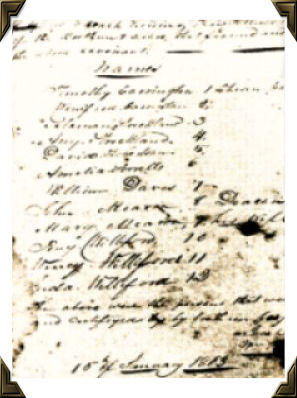 Timothy was a cofounder and the first minister,
and he and wife, Winney, were charter members of Scull
Shoals Baptist Church, which was constituted January
15, 1803, at Scull Shoals in Elbert County, Georgia.
At left is an image of the original Minutes listing
the charter members. Timothy was a cofounder and the first minister,
and he and wife, Winney, were charter members of Scull
Shoals Baptist Church, which was constituted January
15, 1803, at Scull Shoals in Elbert County, Georgia.
At left is an image of the original Minutes listing
the charter members.
In 1804 Rev. Timothy Carrington was again a delegate
to the Sarepta Association meeting. He was asked to
write a letter to the Bethel Association in South
Carolina. He was also a messenger from the Sarepta
Association to the Georgia Association meeting.
In 1807 the Sarepta Association met at Shoals Creek
in Elbert County, and Rev. Timothy Carrington gave the
introductory sermon [a very high honor].
According to the History of the Baptist Denomination
in North America by David Benedict, Rev. Timothy
was still pastor of Scull Shoals Baptist Church in 1813.
The church minutes dated Sep. 12, 1819, recorded that
Timothy was relieved of duty because of age, and he
died in September 1822. The church minutes of May 6,
1826, still listed Winnifred Carrington as a member.

NOTES ON LYSTRA PRIMITIVE
BAPTIST CHURCH
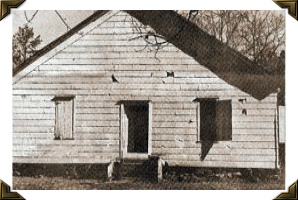 Although
Rev. Timothy Carrington was no longer pastor after 1819
and probably never actually preached in the new church
building erected in Madison County, Georgia in 1820,
he was closely identified with the Lystra Primitive
Baptist Church since he was a charter member and the
first pastor in the original Scull Shoals location.
According to architects, "the [new] building, built
in 1820, contains unique architectural features such
as one-piece ax-hewn beams, dentil molding, L-shaped
corners and wood pegs. In certain spots, original wood
flooring is visible under more recent flooring." Although
Rev. Timothy Carrington was no longer pastor after 1819
and probably never actually preached in the new church
building erected in Madison County, Georgia in 1820,
he was closely identified with the Lystra Primitive
Baptist Church since he was a charter member and the
first pastor in the original Scull Shoals location.
According to architects, "the [new] building, built
in 1820, contains unique architectural features such
as one-piece ax-hewn beams, dentil molding, L-shaped
corners and wood pegs. In certain spots, original wood
flooring is visible under more recent flooring."
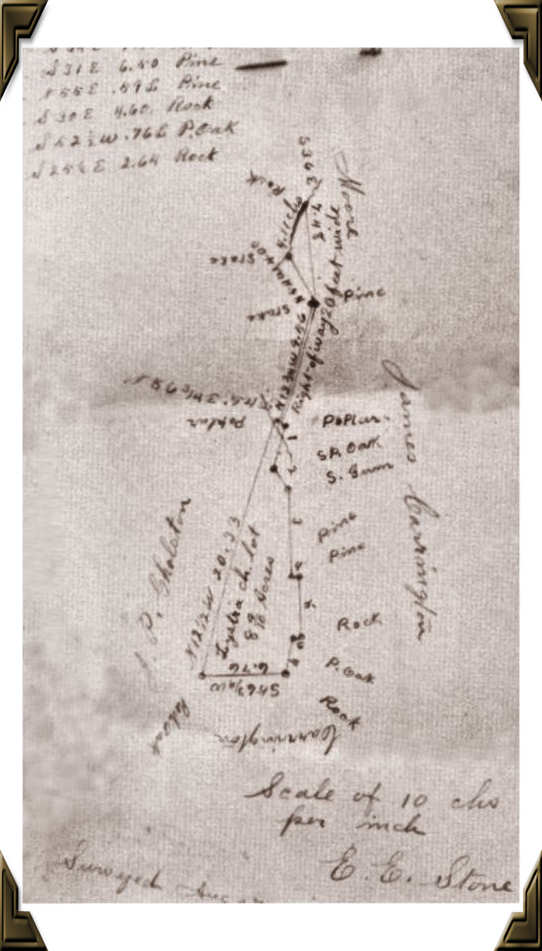 The
Primitive Baptists were "known as 'foot-washing
Baptists' because of the annual practice of following
biblical admonitions to 'wash one another's feet'. This
denomination is characterized by a strong adherence
to the doctrine of predestination. At one time two sets
of benches were positioned on both sides of the church
- one for women and one for men. The benches have long
disappeared to vandals or to those who acquired them
legitimately from the church. The church's cemetery
contains many old graves, some dating back to the 1700s.
1973 marked the last use of the church. Howard Parham
[the last surviving member] presented the deed to the
building and attending 9 acres to Charlotte Bond, president
of the Madison County Heritage Foundation. The
Primitive Baptists were "known as 'foot-washing
Baptists' because of the annual practice of following
biblical admonitions to 'wash one another's feet'. This
denomination is characterized by a strong adherence
to the doctrine of predestination. At one time two sets
of benches were positioned on both sides of the church
- one for women and one for men. The benches have long
disappeared to vandals or to those who acquired them
legitimately from the church. The church's cemetery
contains many old graves, some dating back to the 1700s.
1973 marked the last use of the church. Howard Parham
[the last surviving member] presented the deed to the
building and attending 9 acres to Charlotte Bond, president
of the Madison County Heritage Foundation.
Lystra Church was a topic in the Foxfire 7 book,
and was featured in several newspaper articles over
the years. The original church at Scull Shoals in Elbert
County burned down in 1819 and the replacement church
also had a tragic demise as detailed in the following
newspaper articles.

The Madison County Journal,
April 6, 1994
"THE HISTORY OF OLD LYSTRA," by Frank
Gillispie
In 1803, the Skull Shoals Primitive Baptist Church
was founded in an area that was formerly Elbert County
near Bowman. In 1819 the church burned, forcing the
members to meet in their homes until a new building
could be constructed.
In 1820 a new building was constructed in the newly
formed Madison County nearer the homes of the members.
The name was changed to "Lystra," from the
town in which St. Paul healed a cripple man and then
had to stop people from worshipping him as a God. Paul
stated that "We also are men of like passions with
you and preach unto you that ye should turn from 'these
vanities' unto the Living God..." (Acts, Ch. 14).
Lystra Church was built without adornments. It was
a simple frame structure with hand hewn timbers set
on field stones. The pulpit was simply ornamented with
dentil work around the upper edge. It had sounding boards
behind and above it. The rest of the interior building
was left with beams and rafters exposed.
The framing was assembled using a mortise and tenon
construction technique. In this system, the joints were
placed together, a hole bored through the joint and
a wooden peg driven through the hole, locking the joint
together.
The building was listed on the National Register of
Historic Places.
Due to declining membership, the congregation was
dissolved in 1973.
In 1988, Howard Parham, the last surviving member
of the church deeded the property to the Madison County
Heritage Foundation. The deed contained only one restriction:
"No religious services are to be conducted that
exposes a doctrine other that Primitive Baptist doctrine.
Marriages and funerals are excepted from this restriction."
Due to the isolated location of the building, and
persistent stories of ghosts, vandals had severely damaged
the building. Doors and windows were ripped away and
large holes knocked in the sides of the building. Graffiti
including Satanic messages was spray painted inside
and outside of the building. At times, motorcycles had
been taken inside and used to do "wheelies"
on the fragile floor.
>The final destruction of the building occurred Wednesday
night, March 30, at app 6:30 when someone set the building
afire, burning it to the ground.

The Madison County Journal, Wed., April 6,
1994, Front Page
"LOCAL TEENS CHARGED IN OLD LYSTRA FIRE"
Seven local teenagers are being charged by the Madison
County Sheriff's Office for starting the fire that destroyed
Old Lystra Church last week. Among those charged are
three 13 year old girls, and boys ages 14, 15, 16 and
18 year old Cheyenne Berry Graham of Route 2 Carlton.
They will be charged with First Degree Arson, and 34
counts of Damage to Property/Vandalism.
The teens, who were out of school for Spring Break,
had spent the day riding around and drinking. They decided
to burn the old church for kicks. They pushed over 34
tombstones before lighting the fire.
At press time, six of the teens had been taken into
custody. One of the girls was visiting in Florida and
will be back later in the week.
Sheriff Jack Fortson immediately offered a $500
reward from his own pocket for information on the fire.
Other citizens called and offered to contribute to the
reward fund, which grew to $10,600. Over the weekend,
numerous leads were reported to the Sheriff's office,
including calls from two of the people involved, according
to Fortson. He pointed out that the suspects cannot
be given a reward for turning themselves in. "We
will evaluate all the information received to see if
any of the reward money will be paid," Fortson
said.
The church was constructed in 1820 by early settlers
who had moved from Elbert County. The congregation was
disbanded in 1973. In March of 1988, the building and
land were given to the Madison County Heritage Foundation
by the last surviving trustee, Mr. Howard Parham. The
Foundation had planned to restore the building to be
used by the community for family reunions and as a wedding
chapel.
Because it was built using a mortise and tenon system
of construction, a system of fastening the hand cut
frame together with wooden pegs, the building was listed
on the National Register of Historic Buildings.
Over the years, the isolated structure developed
a reputation as a haunted church. Young men took delight
in bringing dates to the site to scare them. In recent
years the building became a target for vandals. It was
damaged repeatedly by having its doors, windows, and
sides torn out. At one point, someone took a motorcycle
inside to do "wheelies." In several instances,
Satanic symbols were painted on the floor, walls and
window shutters. Graffiti was spray painted on much
of the outside.
As a result of the fire, the roof, floor and walls
were destroyed. Most of the framing was heavily charred.
However, many of the joints with the holes and pegs
are still visible. Also visible are many hand-made nails
used to put on siding and shingles. The pews and pulpit
had been removed from the building and stored in a safe
location.

The Madison County Journal, April 6, 1994,
p. 4
"FRANKLY SPEAKING," by Frank Gillispie
For what shall it profit a man, if he shall gain
the whole world, and lose his own soul? Mark 8:36
Last week, a group believed to be teenage vandals,
burned Old Lystra, Madison County's oldest standing
church building, and pushed over or broke forty or more
tombstones in the old church cemetery. Vandals have
been attacking and defacing the old building with satanic
symbols for several years, and a number of people, including
the writer, had issued repeated warnings that the building
was in danger. Now it is totally destroyed.
The loss was a major one for Madison County. The
building was highly significant, both historically and
architecturally. But its loss is most important because
it illustrates a major flaw that has developed in our
society.
Lystra was built in 1820 to house a Primitive Baptist
Congregation that had been meeting in private homes.
Listed among its members were the ancestors of many
of Madison County's most established families. Many
of those ancestors are buried in the large cemetery
that partly surrounds the building site.
It was built of hand hewn timber framing using the
mortise and tenon system. It contained a pulpit with
a sealed back and ceiling that served as a sounding
board. The remainder of the framing was exposed. The
building was listed on the National Register of Significant
Buildings. Truly, Madison County has lost a valuable
part of its heritage and history.
The loss of Old Lystra illustrates a major problem
that has developed in our society. We have stopped being
responsible for our children. Instead, we devote all
our time to making more money, and grabbing more power
for ourselves. People today feel they are deprived unless
they have all the latest gadgets, a house bigger than
the neighbors, and a prestige car. They spend so much
time working on those goals that they neglect their
most important duty, raising their children.
Others have as their goal, boosting their social
and political power. They want to display their importance
to the community by forcing their opinions on others.
They are more concerned with pushing their political
ideas than they are in protecting such valuable things
as old church buildings. In both cases, they appear
to be going all out to gain the whole world.
Those people who had the responsibility to protect
Old Lystra didn't have the time or inclination to take
the necessary actions. They were too busy at their jobs,
or they couldn't agree on who was in charge, or they
didn't want to allow new people to join their organizations.
It might reduce their sense of power. The political
leaders of the county felt other things were more important,
because they increased their political power. The few
people who tried simply didn't have the resources necessary
to guard the building.
Because too many of our people are concerned with
gaining the whole world, Madison County has lost a part
of its soul.
NEXT: Descendants of Rev. Timothy Carrington (generation
one) 

Backgrounds and graphics created by Diane Carrington Bradford
Copyright © 2000, 2004,2005, 2019, Diane Carrington Bradford, All
rights reserved.
This Web Site was Created Feb 18, 2000; major revision Jun 2005, Jul 2019.
Last updated August 16, 2019 2:28 AM
This site is generously hosted by

|